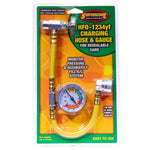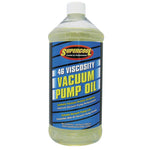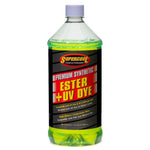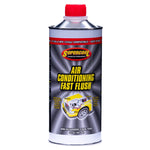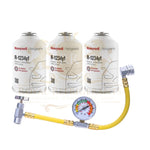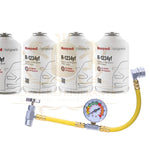You have no items in your shopping cart.
Everything You Need to Know About the Refrigerant Management Program for HVAC and Automotive Applications
The Refrigerant Management Program (RMP) plays a critical role in reducing greenhouse gas (GHG) emissions, preventing ozone depletion, and promoting responsible handling of refrigerants used in HVAC and automotive systems. Whether you’re a technician, contractor, or facility owner, understanding how RMP regulations work is essential for compliance and environmental stewardship.
This guide explains what the Refrigerant Management Program is, why it exists, who it applies to, how to comply, and what changes are coming — especially relevant for HVAC and automotive professionals in 2025 and beyond.
What Is the Refrigerant Management Program?
The Refrigerant Management Program (RMP) is a regulatory framework designed to:
- Track, control, and reduce refrigerant emissions
- Ensure proper maintenance, leak detection, and recordkeeping
- Encourage the use of low-global-warming-potential (GWP) refrigerants
In the U.S., the program is enforced by the Environmental Protection Agency (EPA) under Section 608 of the Clean Air Act, while California’s Air Resources Board (CARB) enforces a stricter state-level RMP for larger stationary refrigeration systems.
Many other countries have similar programs under international environmental protocols (like the Montreal Protocol and Kigali Amendment).
Why the Program Was Created
Refrigerants such as R22, R134A, and R410A can release potent greenhouse gases when leaked or improperly disposed of. Even small leaks can have a major environmental impact:
- R134A has a GWP of ~1,430
- R410A has a GWP of ~2,088
- R22 and R502 contribute to ozone depletion
The RMP helps reduce these emissions by:
- Promoting regular leak inspections
- Requiring certified technicians for refrigerant handling
- Enforcing reporting and recordkeeping
- Supporting the transition to lower-GWP alternatives
-

Who Must Comply with the Refrigerant Management Program?
🏢 HVAC and Refrigeration System Owners
Facilities with large refrigeration or air-conditioning systems — such as supermarkets, warehouses, cold storage, and office buildings — must comply if they use refrigerants above a certain charge size.
In California, compliance applies if:
- The system contains ≥ 50 pounds of high-GWP refrigerant
- You operate stationary HVAC or refrigeration systems (R22, R404A, R407C, R410A, etc.)
🚗 Automotive Service Providers
Auto repair shops and technicians servicing vehicle A/C systems (R134A, R1234yf) must comply with EPA Section 609 requirements:
- Use certified recovery/recycling equipment
- Maintain records of refrigerant purchases and recovery
- Ensure proper technician certification
Key Components of the Refrigerant Management Program
1. Registration and Equipment Tracking
Owners of systems containing 50+ pounds of refrigerant must:
- Register with CARB (California) or EPA (for federal systems)
- Report system details: type, capacity, and refrigerant used
2. Leak Inspection Requirements
Depending on system size and refrigerant charge, inspections are required:
| System Size (lbs) | Inspection Frequency |
|---|---|
| 50–200 | Every 12 months |
| 200–2,000 | Every 3 months |
| >2,000 | Monthly |
If a leak is detected:
- Must be repaired within 14 days
- Retested within 30 days to confirm repair success
3. Leak Rate Thresholds
- EPA requires repair if leak rate exceeds:
- 10% for comfort cooling
- 20% for commercial refrigeration
- 30% for industrial process refrigeration
4. Recordkeeping
Owners and operators must maintain:
- Leak inspection reports
- Service logs and refrigerant purchase receipts
- Technician certifications
- Disposal and recovery documentation
Records must typically be retained for at least 3 years.
5. Refrigerant Recovery and Recycling
Technicians must use EPA-certified recovery machines to capture refrigerants during service or disposal. Venting refrigerants into the atmosphere is strictly prohibited.
Refrigerant Management in California (CARB RMP 2025 Updates)
California’s CARB Refrigerant Management Program (Title 17, CCR §95380–95398) sets the nation’s most comprehensive refrigerant tracking system.
Key 2025 Updates:
- Ban on sale of virgin refrigerants with GWP > 2,200 starting January 1, 2025 (under SB 1206).
- Enhanced digital reporting system (R3) for leak and service data.
- Expanded enforcement and higher penalties for failure to report leaks or register systems.
- Continued incentives for using reclaimed or low-GWP refrigerants (like R448A, R449A, R513A, and CO₂).
For California businesses, non-compliance can result in fines up to $10,000 per day per violation.
Automotive Refrigerant Management (Section 609)
For automotive A/C systems:
- Only EPA-certified Section 609 technicians may buy or handle small cans of R134A or R1234yf.
- Automotive shops must:
- Use certified recovery/recycling equipment
- Label service equipment correctly
- Keep records of refrigerant recovery and sales
- Return or properly dispose of empty refrigerant containers
DIY Restrictions
Consumers in California must follow CARB’s small-container refrigerant rule, which includes:
- Deposit–return system for small R134A cans (phasing out in 2025)
- Mandatory self-sealing valves on all small containers
Benefits of a Strong Refrigerant Management Program
✅ Reduces greenhouse gas emissions
✅ Saves money by preventing refrigerant loss
✅ Ensures legal compliance
✅ Protects the environment and ozone layer
✅ Extends equipment life and performance
How to Stay Compliant
- Register all large HVAC and refrigeration systems with the proper agency (EPA or CARB).
- Schedule leak inspections based on system charge size.
- Repair leaks within the legal timeframe.
- Maintain accurate service and refrigerant records.
- Train and certify technicians under Section 608 or 609.
- Switch to low-GWP refrigerants when retrofitting or upgrading.
- Label all systems with refrigerant type and GWP for easy tracking.
Future of Refrigerant Management
The trend is clear — refrigerant management will continue to evolve toward:
- Digitized reporting systems
- Automated leak detection
- Low-GWP refrigerants (R32, R454B, R1234yf)
- Recovery and reclamation incentives
- Global phase-down of HFCs under the Kigali Amendment
Technicians and companies who adapt early will stay compliant and competitive.
Conclusion
The Refrigerant Management Program ensures responsible use, recovery, and disposal of refrigerants in HVAC and automotive systems. With stricter global and state regulations taking effect (especially in California by 2025), compliance is more important than ever.
By maintaining good leak prevention, proper technician certification, and transitioning toward low-GWP refrigerants, you not only stay legal but also help protect the planet for future generations.
 English
English

